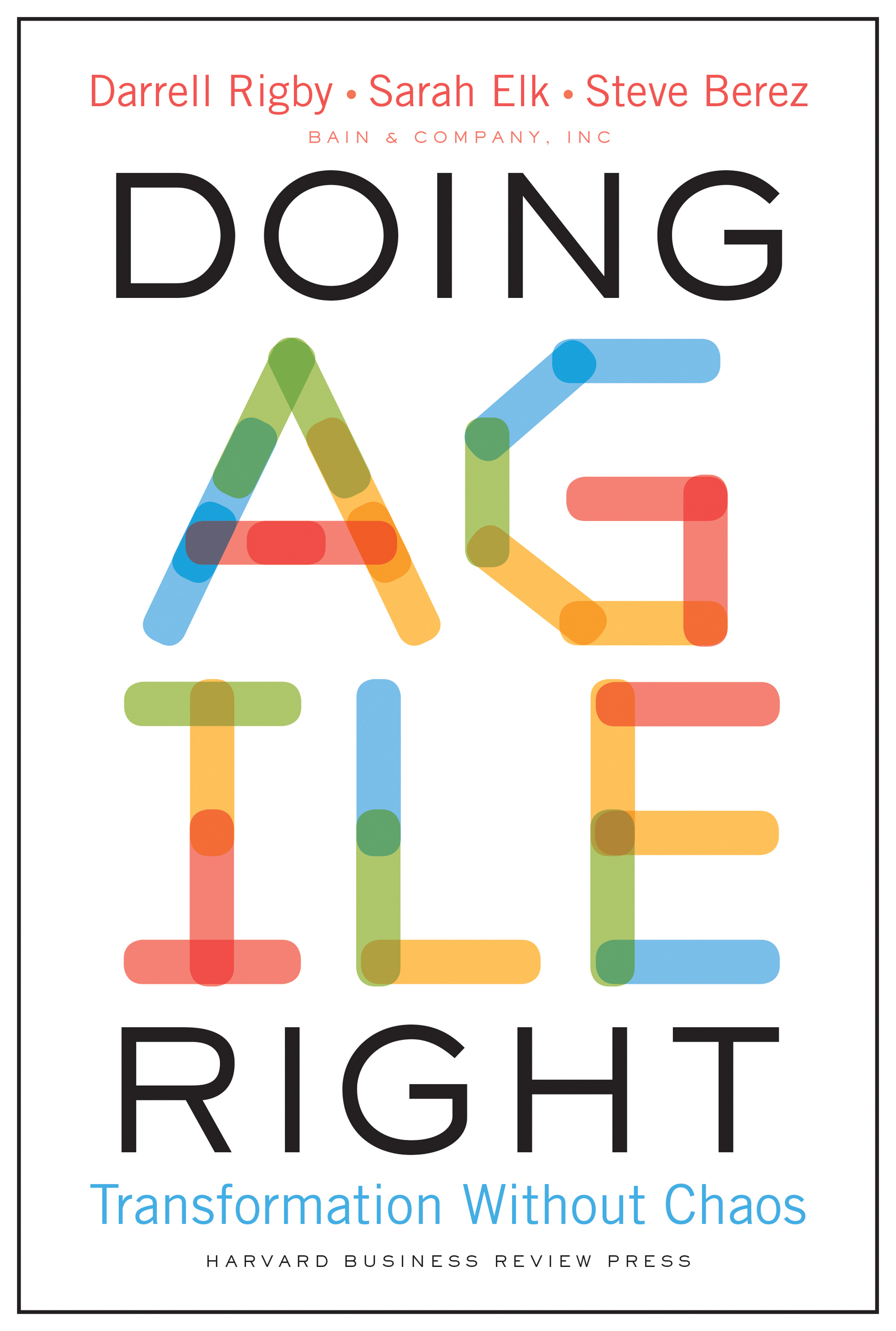Darrell K. Rigby - Doing Agile Right
Here you can read online Darrell K. Rigby - Doing Agile Right full text of the book (entire story) in english for free. Download pdf and epub, get meaning, cover and reviews about this ebook. year: 2020, publisher: Harvard Business Review Press, genre: Business. Description of the work, (preface) as well as reviews are available. Best literature library LitArk.com created for fans of good reading and offers a wide selection of genres:
Romance novel
Science fiction
Adventure
Detective
Science
History
Home and family
Prose
Art
Politics
Computer
Non-fiction
Religion
Business
Children
Humor
Choose a favorite category and find really read worthwhile books. Enjoy immersion in the world of imagination, feel the emotions of the characters or learn something new for yourself, make an fascinating discovery.

- Book:Doing Agile Right
- Author:
- Publisher:Harvard Business Review Press
- Genre:
- Year:2020
- Rating:3 / 5
- Favourites:Add to favourites
- Your mark:
- 60
- 1
- 2
- 3
- 4
- 5
Doing Agile Right: summary, description and annotation
We offer to read an annotation, description, summary or preface (depends on what the author of the book "Doing Agile Right" wrote himself). If you haven't found the necessary information about the book — write in the comments, we will try to find it.
Doing Agile Right — read online for free the complete book (whole text) full work
Below is the text of the book, divided by pages. System saving the place of the last page read, allows you to conveniently read the book "Doing Agile Right" online for free, without having to search again every time where you left off. Put a bookmark, and you can go to the page where you finished reading at any time.
Font size:
Interval:
Bookmark:

Highly recommended. A sparkling book that is not only easy to read and digest in one day but also packed with useful tips. Applicable to everyone, with clear dos and donts for all leadership styles. This book is a must-read for skeptics as well as believers that agile can lead to sustainable success.
CARLO VIVALDI, Co-Chief Operating Officer, UniCredit
No matter where your company is on its journey to agile, Doing Agile Right serves as a useful guidebook for senior management teams. The authors bring decades of experience and perspective to demystifying an often misunderstood topic.
RITCH ALLISON, CEO, Dominos Pizza
Business leaders responsible for leading transformative change will benefit greatly from Doing Agile Right. The specific examples and empirical evidence show how agile helps a company innovate and evolve.
PAUL SANFORD, Senior Vice President, Solutions Delivery, Cigna
Doing Agile Right lays out the steps organization-wide that allow traditional companies to perform software development like digital natives. CIOs and their business partners in the digital transformation journey will find this book an invaluable road map.
MICHELLE A. ROUTH, Chief Information Officer, CARE USA
Having experienced as a practitioner many of the challenges of large-scale agile transformation, I value this unfiltered view of the journey to agility. Every step has practical examples highlighting dos and donts.
PRAT VEMANA, Senior Vice President and Chief Digital Officer, Kaiser Permanente
Darrell RigbySarah ElkSteve Berez
BAIN & COMPANY, INC.
DOING

RIGHT
Transformation Without Chaos
HARVARD BUSINESS REVIEW PRESSBOSTON, MASSACHUSETTS
HBR Press Quantity Sales Discounts
Harvard Business Review Press titles are available at significant quantity discounts when purchased in bulk for client gifts, sales promotions, and premiums. Special editions, including books with corporate logos, customized covers, and letters from the company or CEO printed in the front matter, as well as excerpts of existing books, can also be created in large quantities for special needs.
For details and discount information for both print and
ebook formats, contact ,
tel. 800-988-0886, or www.hbr.org/bulksales.
Copyright 2020 Bain & Company, Inc.
All rights reserved
No part of this publication may be reproduced, stored in or introduced into a retrieval system, or transmitted, in any form, or by any means (electronic, mechanical, photocopying, recording, or otherwise), without the prior permission of the publisher. Requests for permission should be directed to , or mailed to Permissions, Harvard Business School Publishing, 60 Harvard Way, Boston, Massachusetts 02163.
The web addresses referenced in this book were live and correct at the time of the books publication but may be subject to change.
Library of Congress Cataloging-in-Publication Data
Names: Rigby, Darrell, author. | Berez, Steve, author. | Elk, Sarah, author.
Title: Doing agile right : transformation without chaos / by Darrell Rigby, Steve Berez, and Sarah Elk (Bain & Company, Inc.).
Description: Boston, MA : Harvard Business Review Press, [2020] | Includes index.
Identifiers: LCCN 2019054607 | ISBN 9781633698703 (hardcover) | ISBN 9781633698710 (ebook)
Subjects: LCSH: Agile project management. | Success in business.
Classification: LCC HD69.P75 R33 2020 | DDC 658.4/06dc23
LC record available at https://lccn.loc.gov/2019054607
ISBN: 978-1-63369-870-3
eISBN: 978-1-63369-871-0
To those who share our belief that great businesses should produce better peopleand to the colleagues and clients who make our own work and growth so fulfilling.
Agilethe business philosophy that relies on fast-moving, self-managing teams for innovationhas officially entered the mainstream of corporate management. Tour almost any large company these days and you will find scores of agile teams working to improve customer experiences and business processes. John Deere has used agile methods to develop new machines, USAA to transform its customer service, and 3M to run a major merger integration. Boscha global supplier of technology and services with more than 400,000 associateshas adopted agile principles to guide a step-by-step reshaping of the company. Digital natives such as Amazon, Netflix, and Spotify have incorporated agile methods into a wide range of innovation activities. Meanwhile, agile has virtually taken over IT departments, themselves the source of countless innovations. At last count, 85 percent of software developers use agile techniques in their work.
The reasons for agiles rapid spread are neither obscure nor surprising. Most big companies find it difficult to innovate. They are weighted down by the structures and procedures of bureaucracy. Agile liberates the innovative spirit that so many organizations stifle. It helps companies reshape both what they offer their customers and how they operate internally. It transforms the work environment, making peoples jobs more rewarding.
These are grand claims, but the data support them. Study after study find conclusively that agile teams are far more successful at innovation than teams that work in traditional fashion. Improvements come rapidly and at less expense. Satisfaction and engagement among employees rise. Moreover, companies can implement agile without the need to spin off separate business units or hide skunkworks from hierarchies. They can deploy agile teams in any business or function that might benefit from them, including corporate headquarters. Once they have learned the basics, they can scale agile, establishing hundreds of individual teams or teams of teams to tackle large projects. Saabs aeronautics business created more than one hundred agile teams operating across software, hardware, and fuselage for its Gripen fighter jeta $43 million item that is certainly one of the most complex products in the world. Military analyst Janes has deemed the Gripen the worlds most cost-effective military aircraft.
So agile is spreading, and agile teams are mostly achieving their objectives. It looks like encouraging progress toward an appealing vision. Is there anything wrong with this picture?
Certainly theres nothing wrong with the basic idea. We are business consultants, and we have seen the power and potential of agile in hundreds of companies around the globe. We have helped many of these companies implement agile. We count ourselves among its biggest fans.
But as with so many good ideas, the practice sometimes belies the promise. Agile has spread so rapidly that it threatens to spin out of control. Along with the companies that use it effectively are those that misunderstand or misuse the ideas. They may be egged on by some zealot who promises the world. They may sign on to an agile transformation before they know anything about what such an effort might entail. They may use agile terminology to camouflage distinctly nonagile objectives.
The outcome of these misuses in many companies is chaos rather than constructive change. But the damage is greater than any one companys experience. When agile is done wrong, it almost always leads to lousy results. Lousy results lead to nervous customers, dissatisfied employees, activist investors, and a push to replace the management team. Replacement managers are understandably skeptical of any strategies that got the prior regime fired. They are likely to clean house, disband agile teams, and (probably) launch a round of layoffs. Its a version of Greshams law: bad agile drives out good. If that happens too often, agile will be discreditedand the business world will be back where it started, with top-heavy bureaucratic corporations struggling hopelessly to keep up with brash upstarts and rapidly changing markets.
Font size:
Interval:
Bookmark:
Similar books «Doing Agile Right»
Look at similar books to Doing Agile Right. We have selected literature similar in name and meaning in the hope of providing readers with more options to find new, interesting, not yet read works.
Discussion, reviews of the book Doing Agile Right and just readers' own opinions. Leave your comments, write what you think about the work, its meaning or the main characters. Specify what exactly you liked and what you didn't like, and why you think so.








